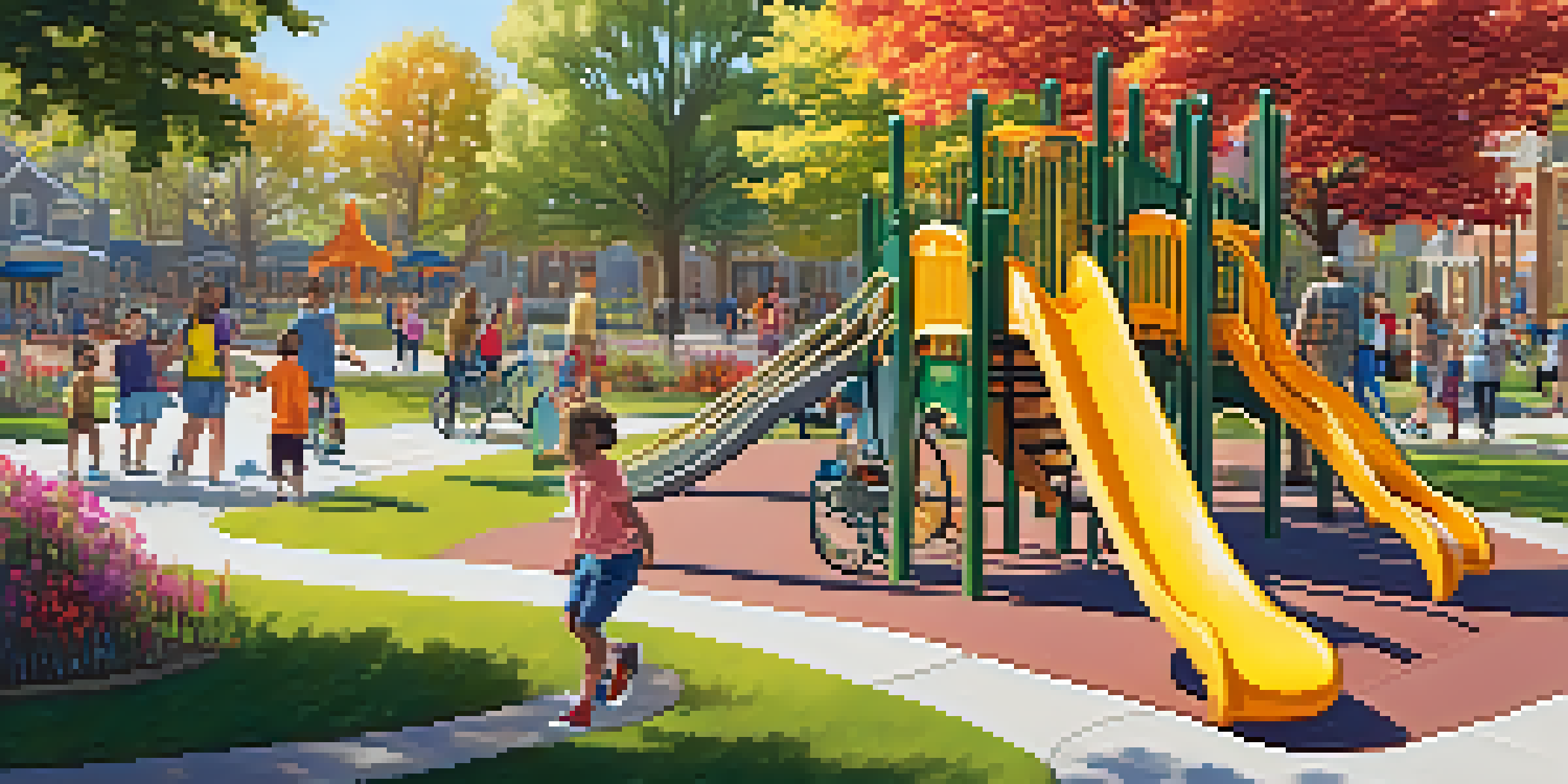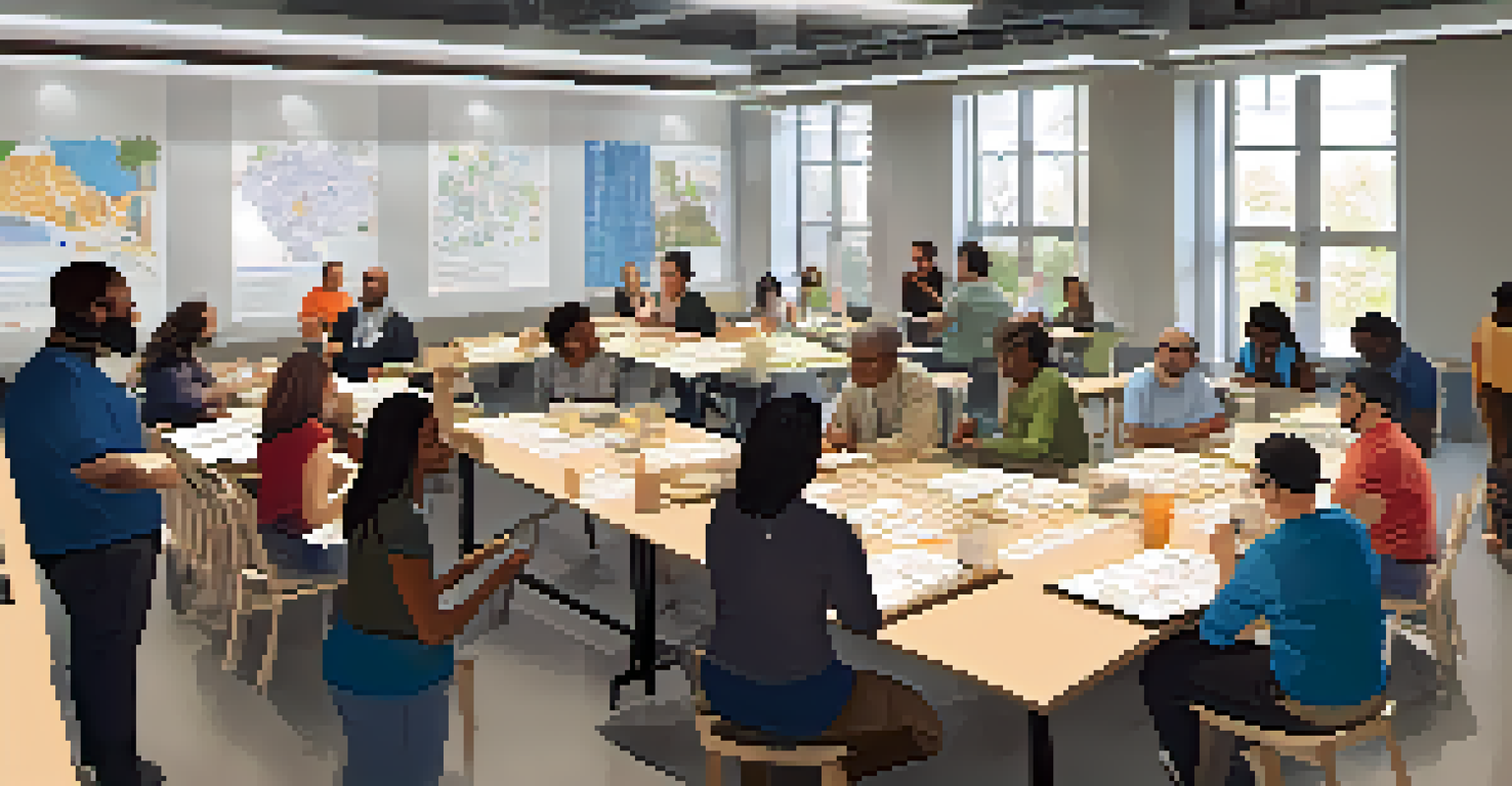Inclusive Urban Design: Making Cities Accessible

Understanding Inclusive Urban Design and Its Importance
Inclusive urban design focuses on creating spaces that everyone can access, regardless of their abilities or age. Imagine a city where everyone—from young children to seniors—can navigate streets, parks, and public transport with ease. This approach not only benefits individuals with disabilities but enhances the overall quality of life for all citizens. By prioritizing inclusivity, cities can foster a sense of belonging and community.
The best way to predict the future is to create it.
At its core, inclusive design aims to eliminate barriers that prevent people from fully participating in urban life. Think about the last time you encountered a step without a ramp or a bus stop without a shelter; these small details can significantly affect how accessible a city feels. When urban planners consider diverse needs, they create environments that empower everyone to engage in daily activities, like shopping, commuting, or enjoying recreational spaces.
Moreover, inclusive urban design contributes to social equity. It ensures that marginalized communities have equal access to resources and opportunities. When cities embrace inclusive design principles, they send a powerful message that every resident's needs matter, fostering a culture of respect and understanding.
Key Principles of Inclusive Urban Design
There are several foundational principles that guide inclusive urban design. First and foremost is universal accessibility, which means designing spaces that anyone can use, regardless of their physical abilities. For example, curb cuts in sidewalks allow wheelchair users and parents with strollers to navigate streets safely. This principle extends to public buildings, parks, and transportation systems, promoting seamless movement throughout the city.

Another vital principle is flexibility in design, catering to a wide range of needs and preferences. For instance, parks can include various types of play equipment that accommodate children with different abilities. Creating multi-sensory environments can engage people more fully, making public spaces enjoyable for everyone, whether they prefer quiet gardens or active playgrounds.
Importance of Inclusive Design
Inclusive urban design enhances accessibility for all, fostering a sense of community and belonging.
Lastly, participatory design is essential, involving community members in the planning process. By gathering input from diverse voices, city planners can identify specific needs and preferences. This collaboration not only leads to more effective designs but also fosters a sense of ownership and pride among residents, reinforcing the idea that everyone has a stake in their community.
The Role of Technology in Inclusive Urban Design
Technology plays a crucial role in enhancing urban accessibility. Smart city initiatives, such as mobile apps that provide real-time information about public transport accessibility, can significantly improve navigation for people with disabilities. Imagine having an app that alerts users to the nearest accessible bus stop or informs them about elevator availability in subway stations—this kind of support can transform daily commuting experiences.
Inclusion is not a privilege, it is a right.
Moreover, incorporating assistive technologies into public spaces can further enhance inclusivity. For instance, audio signals at crosswalks can help visually impaired individuals navigate intersections safely. Similarly, tactile paving can guide those with vision loss along sidewalks. By integrating these technologies into urban design, cities can create safer and more user-friendly environments.
Finally, data collection through technology can help identify areas needing improvement. By analyzing how different populations use urban spaces, city planners can pinpoint accessibility gaps and prioritize updates. Utilizing data-driven approaches ensures that inclusive urban design evolves alongside the needs of the community.
Case Studies: Cities Leading in Inclusive Design
Several cities around the world exemplify the principles of inclusive urban design. For example, Copenhagen has implemented extensive bike lanes and pedestrian-friendly zones, making it accessible for everyone, including those with mobility challenges. Their commitment to inclusivity has not only improved accessibility but also enhanced overall quality of life, as more residents feel encouraged to explore their city.
Another notable example is Toronto, which has invested in public transportation improvements aimed at increasing accessibility. The city's transit system features low-floor buses and accessible subway stations, making it easier for individuals with disabilities to navigate urban spaces. These efforts demonstrate how thoughtful planning can create a more inclusive environment for all citizens.
Key Principles to Guide Design
Universal accessibility, flexibility, and participatory design are essential principles that ensure urban spaces meet diverse needs.
Lastly, Melbourne has embraced a 'design for everyone' philosophy in its urban planning. The city's commitment to inclusive parks, libraries, and public squares has made these spaces welcoming for diverse populations. By showcasing these successful initiatives, these cities serve as models for others aiming to enhance accessibility in their urban environments.
Challenges in Implementing Inclusive Urban Design
Despite the clear benefits, implementing inclusive urban design can come with challenges. One major hurdle is funding—cities often have limited budgets, making it difficult to prioritize accessibility projects. However, investing in inclusive design not only serves a moral obligation but also has long-term economic benefits, as accessible cities can attract more visitors and residents alike.
Resistance to change can also pose a significant barrier. Some stakeholders may be hesitant to adopt new designs or technologies, fearing disruption or increased costs. It's crucial for city planners to effectively communicate the advantages of inclusive design and engage with the community to build support for these initiatives. By showcasing successful examples and demonstrating the positive impact on all residents, they can alleviate concerns and foster a collaborative environment.
Finally, keeping up with evolving accessibility standards can be daunting. Regulations and best practices continually change, requiring ongoing education and training for planners and architects. Cities must stay informed and adaptable, ensuring that their designs meet current needs while anticipating future demands.
Community Involvement in Urban Design Decisions
Community involvement is essential for successful inclusive urban design. Engaging local residents, especially those with disabilities, ensures that their voices are heard in the planning process. When community members actively participate, they can share their experiences and insights, helping planners understand the unique challenges they face in navigating urban spaces.
Public meetings, workshops, and surveys are effective ways to gather input from diverse populations. For example, cities can host design charrettes where residents collaborate with planners to brainstorm solutions. This participatory approach fosters a sense of ownership and pride among community members, who feel invested in creating spaces that meet everyone's needs.
Technology Enhances Accessibility
Innovative technologies, like smart apps and assistive devices, play a crucial role in improving navigation and safety for individuals with disabilities.
Moreover, ongoing feedback from residents can help cities refine their designs over time. By establishing channels for communication, such as online platforms or regular forums, urban planners can continually assess the effectiveness of their initiatives. This commitment to collaboration not only strengthens community ties but also ensures that urban spaces remain relevant and accessible for all.
The Future of Inclusive Urban Design
As cities continue to grow and evolve, the future of inclusive urban design looks promising. With an increasing awareness of the importance of accessibility, more planners and architects are prioritizing inclusive principles in their projects. This shift marks a significant step toward creating cities that truly cater to all residents, regardless of their abilities or backgrounds.
Additionally, advancements in technology will continue to play a vital role in shaping inclusive urban environments. Innovations such as augmented reality can enhance navigation for individuals with disabilities, providing real-time guidance and information about their surroundings. As these technologies become more integrated into urban design, they will further empower individuals to navigate their cities with confidence.

Ultimately, the future of inclusive urban design hinges on collaboration, innovation, and a commitment to community. By working together, cities can create vibrant, accessible spaces that foster connection and belonging for everyone, ensuring that no one is left behind in the urban landscape.